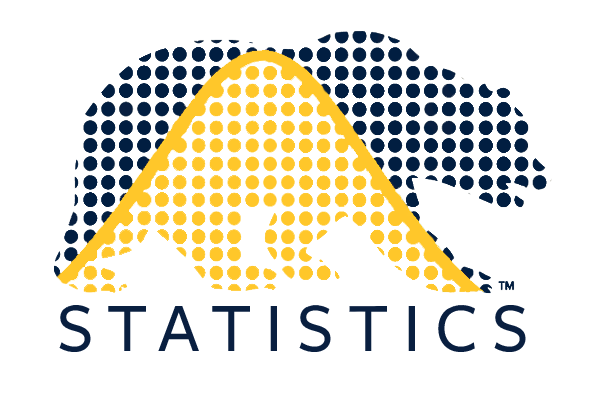
CV | Google Scholar | Github | Twitter |
Amanda Coston is an Assistant Professor in the Department of Statistics at UC Berkeley. Her work considers how -- and when -- machine learning and causal inference can improve decision-making in societally high-stakes settings. Her research addresses real-world data problems that challenge the validity, equity, and reliability of algorithmic decision support systems and data-driven policy-making. A central focus of her research is identifying when algorithms, data used for policy-making, and human decisions disproportionately impact marginalized groups. Amanda earned her PhD in Machine Learning and Public Policy at Carnegie Mellon University (CMU) where she was advised by the incredible duo Alexandra Chouldechova and Edward H. Kennedy. Amanda completed a postdoc at Microsoft Research in the Machine Learning and Statistics Team. Amanda is an Okawa Foundation grant recipient, a Schmidt Sciences AI 2050 Early Career Fellow, a Rising Star in EECS, Machine Learning and Data Science, Meta Research PhD Fellow, NSF GRFP Fellow, K & L Gates Presidential Fellow in Ethics and Computational Technologies, and a TCS Presidential Fellow. Her work has been recognized by best paper awards and featured in The Wall Street Journal and VentureBeat. |
| 2025 | Awarded the Okawa Foundation research grant. |
| 2024 | AI 2050 Early Career Fellowship by Schmidt Sciences. |
| 2023 | Honorable mention in CMU School of Computer Science Distinguished Dissertation Award. |
| 2023 | William W. Cooper Doctoral Dissertation Award in Management or Management Science from Carnegie Mellon University for the dissertation Principled Machine Learning for Societally Consequential Decision Making. |
| 2023 | Best Paper Award at FAccT with Luke, Ken, and Zhiwei Steven for counterfactual prediction under measurement error and selection bias. |
| 2023 | William W. Cooper Doctoral Dissertation Award in Management or Management Science from Carnegie Mellon University for the dissertation Principled Machine Learning for Societally Consequential Decision Making. |
| 2023 | Best Paper Award at SaTML with Anna, Haiyi, Ken and Hoda for centering validity in evaluating justified use of algorithms. |
| 2022 | Rising Star in Data Science at the University of Chicago. |
| 2022 | Rising Star in Machine Learning at the University of Maryland. |
| 2022 | Rising Star in EECS 2022 at UT-Austin. |
| 2022 | Meta Research PhD Fellow. |
| 2022 | Future Leader in Responsible Data Science. |
| 2020 | K & L Gates Presidential Fellow in Ethics and Computational Technologies. |
| 2019 | Tata Consultancy Services (TCS) Presidential Fellowship. |
| 2018 | Suresh Konda Best First Student Research Paper Award from the Heinz College for counterfactual evaluation in child welfare. |
| 2018 | NSF GRFP Fellow. |
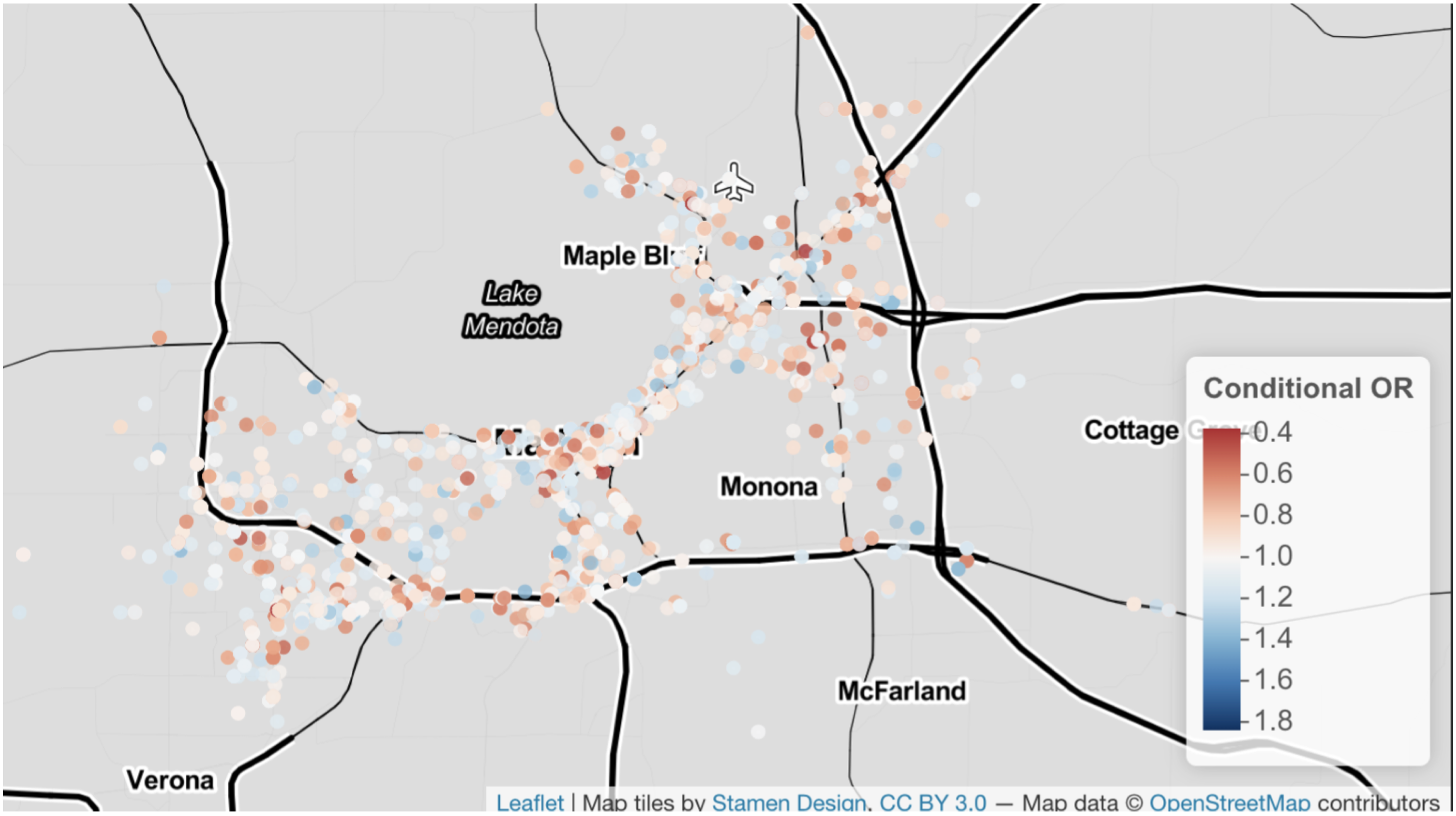 |
Oral presentation (20% selection rate)
Abstract |
Talk
Racial bias in criminal justice has profound consequences. This bias harms not only the participant of the encounter but also has far-reaching implications, particularly in the era of big data. These interactions are often recorded and used to build algorithms that shape future encounters with the criminal justice system. In order to guard against automating biases in these high-stakes algorithms, we must identify when and where bias occurs in the criminal justice pipeline. We consider racial bias in one of the most common points of entry: police traffic stops. Building on the tradition that uses the "veil of darkness" to test for racial bias in officer's decisions to stop, we propose a counterfactual audit for racial bias that clarifies the assumptions needed to identify racial bias. A central challenge is that standard measures of effect are not identifiable due to the outcome-dependent sampling of police traffic stop data. As a solution, we identify an odds ratio that recovers a test for differences in the race-conditional risk ratios under Bernoulli sampling. We propose an efficient estimator for the identified odds ratio using doubly-robust techniques that allow for flexible, non-parametric estimation. We present empirical results on the Stanford Open Policing data. |
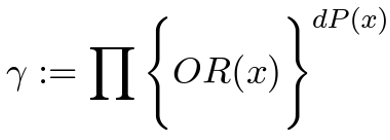 |
Abstract |
ArXiv
Historically used in settings where the outcome is rare or data collection is expensive, outcome-dependent sampling is relevant to many modern settings where data is readily available for a biased sample of the target population, such as public administrative data. Under outcome-dependent sampling, common effect measures such as the average risk difference and the average risk ratio are not identified, but the conditional odds ratio is. Aggregation of the conditional odds ratio is challenging since summary measures are generally not identified. Furthermore, the marginal odds ratio can be larger (or smaller) than all conditional odds ratios. This so-called non-collapsibility of the odds ratio is avoidable if we use an alternative aggregation to the standard arithmetic mean. We provide a new definition of collapsibility that makes this choice of aggregation method explicit, and we demonstrate that the odds ratio is collapsible under geometric aggregation. We describe how to partially identify, estimate, and do inference on the geometric odds ratio under outcome-dependent sampling. Our proposed estimator is based on the efficient influence function and therefore has doubly robust-style properties. |
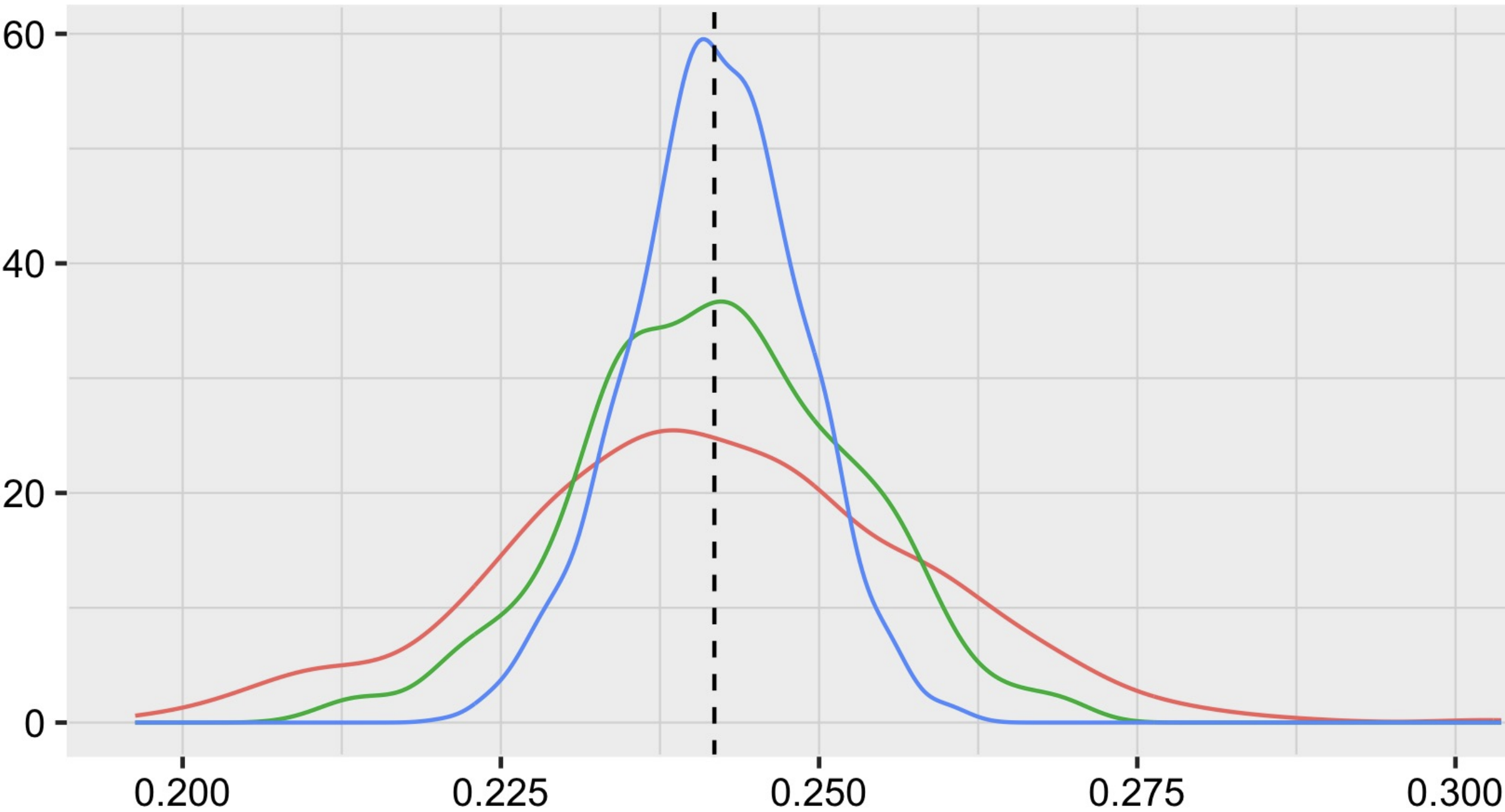 |
• NeurIPS Workshop on Algorithmic Fairness through the Lens of Causality and Privacy, 2022
Abstract |
ArXiv
Predictive algorithms inform consequential decisions in settings where the outcome is selectively observed given some choices made by human decision makers. There often exists unobserved confounders that affected the decision maker's choice and the outcome. We propose a unified methodology for the robust design and evaluation of predictive algorithms in selectively observed data under such unobserved confounding. Our approach imposes general assumptions on how much the outcome may vary on average between unselected and selected units conditional on observed covariates and identified nuisance parameters, formalizing popular empirical strategies for imputing missing data such as proxy outcomes and instrumental variables. We develop debiased machine learning estimators for the bounds on a large class of predictive performance estimands, such as the conditional likelihood of the outcome, a predictive algorithm's mean square error, true/false positive rate, and many others, under these assumptions. In an administrative dataset from a large Australian financial institution, we illustrate how varying assumptions on unobserved confounding leads to meaningful changes in default risk predictions and evaluations of credit scores across sensitive groups. |
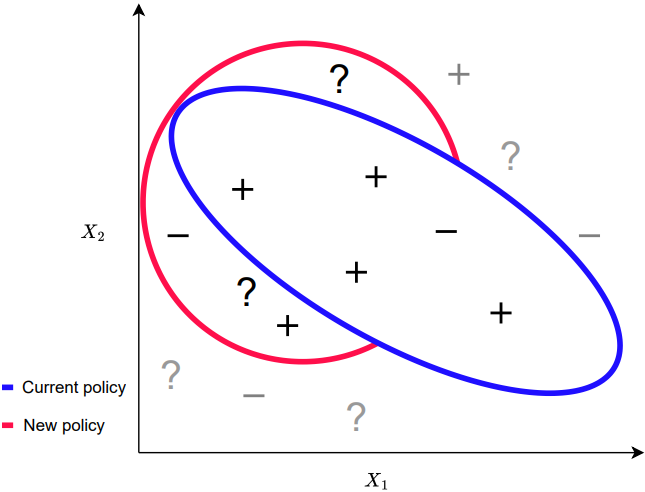 |
Abstract |
Paper |
ArXiv
Predictive models are often introduced to decision-making tasks under the rationale that they improve performance over an existing decision-making policy. However, it is challenging to compare predictive performance against an existing decision-making policy that is generally under-specified and dependent on unobservable factors. These sources of uncertainty are often addressed in practice by making strong assumptions about the data-generating mechanism. In this work, we propose a method to compare the predictive performance of decision policies under a variety of modern identification approaches from the causal inference and off-policy evaluation literatures (e.g., instrumental variable, marginal sensitivity model, proximal variable). Key to our method is the insight that there are regions of uncertainty that we can safely ignore in the policy comparison. We develop a practical approach for finite-sample estimation of regret intervals under no assumptions on the parametric form of the status quo policy. We verify our framework theoretically and via synthetic data experiments. We conclude with a real-world application using our framework to support a pre-deployment evaluation of a proposed modification to a healthcare enrollment policy. |
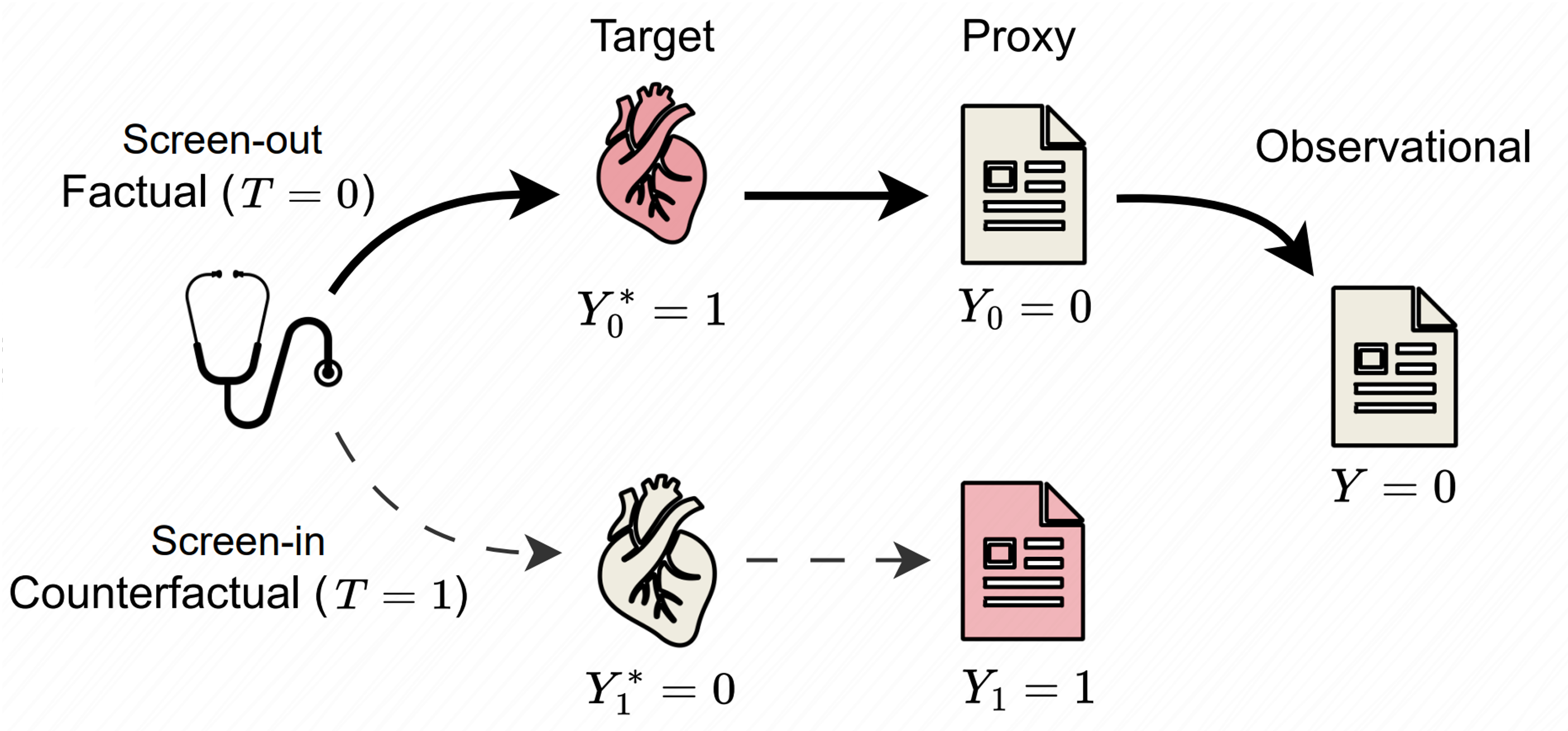 |
Abstract |
Paper |
ArXiv |
Talk
Across domains such as medicine, employment, and criminal justice, predictive models often target labels that imperfectly reflect the outcomes of interest to experts and policymakers. For example, clinical risk assessments deployed to inform physician decision-making often predict measures of healthcare utilization (e.g., costs, hospitalization) as a proxy for patient medical need. These proxies can be subject to outcome measurement error when they systematically differ from the target outcome they are intended to measure. However, prior modeling efforts to characterize and mitigate outcome measurement error overlook the fact that the decision being informed by a model often serves as a risk-mitigating intervention that impacts the target outcome of interest and its recorded proxy. Thus, in these settings, addressing measurement error requires counterfactual modeling of treatment effects on outcomes. In this work, we study intersectional threats to model reliability introduced by outcome measurement error, treatment effects, and selection bias from historical decision-making policies. We develop an unbiased risk minimization method which, given knowledge of proxy measurement error properties, corrects for the combined effects of these challenges. We also develop a method for estimating treatment-dependent measurement error parameters when these are unknown in advance. We demonstrate the utility of our approach theoretically and via experiments on real-world data from randomized controlled trials conducted in healthcare and employment domains. As importantly, we demonstrate that models correcting for outcome measurement error or treatment effects alone suffer from considerable reliability limitations. Our work underscores the importance of considering intersectional threats to model validity during the design and evaluation of predictive models for decision support. |
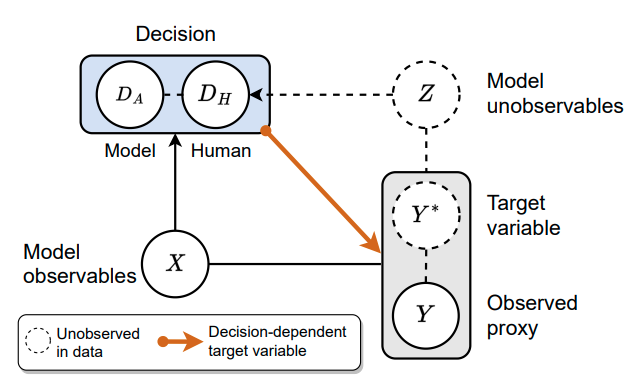 |
Abstract |
Paper |
ArXiv |
Talk
A growing literature on human-AI decision-making investigates strategies for combining human judgment with statistical models to improve decision-making. Research in this area often evaluates proposed improvements to models, interfaces, or workflows by demonstrating improved predictive performance on "ground truth" labels. However, this practice overlooks a key difference between human judgments and model predictions. Whereas humans reason about broader phenomena of interest in a decision - including latent constructs that are not directly observable, such as disease status, the "toxicity" of online comments, or future "job performance" - predictive models target proxy labels that are readily available in existing datasets. Predictive models' reliance on simplistic proxies makes them vulnerable to various sources of statistical bias. In this paper, we identify five sources of target variable bias that can impact the validity of proxy labels in human-AI decision-making tasks. We develop a causal framework to disentangle the relationship between each bias and clarify which are of concern in specific human-AI decision-making tasks. We demonstrate how our framework can be used to articulate implicit assumptions made in prior modeling work, and we recommend evaluation strategies for verifying whether these assumptions hold in practice. We then leverage our framework to re-examine the designs of prior human subjects experiments that investigate human-AI decision-making, finding that only a small fraction of studies examine factors related to target variable bias. We conclude by discussing opportunities to better address target variable bias in future research. |
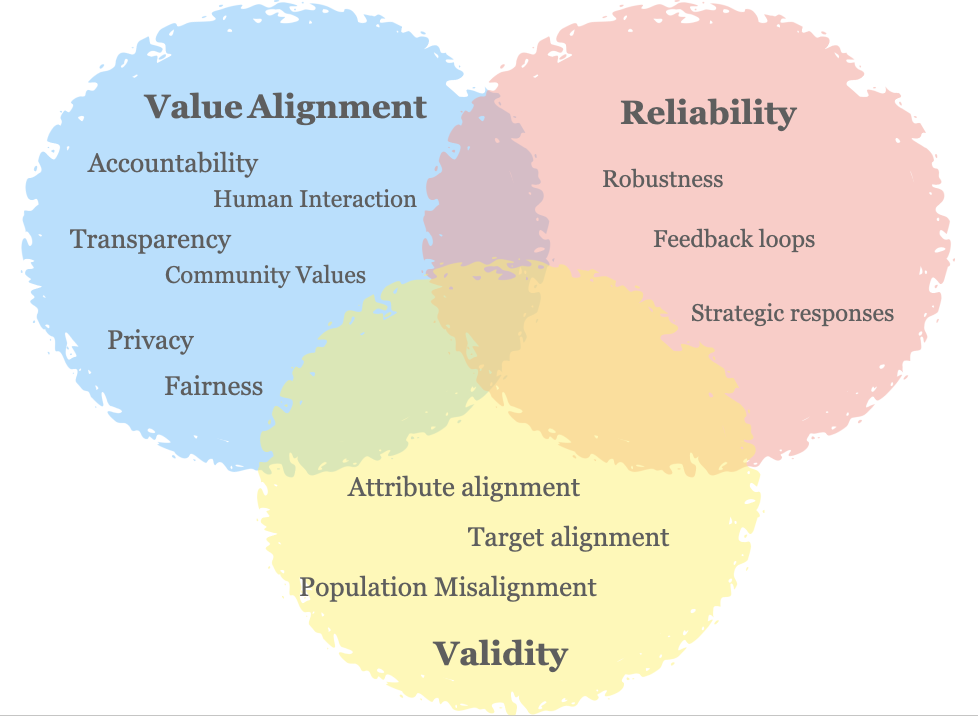 |
Abstract |
Paper |
ArXiv
Recent research increasingly brings to question the appropriateness of using predictive tools in complex, real-world tasks. While a growing body of work has explored ways to improve value alignment in these tools, comparatively less work has centered concerns around the fundamental justifiability of using these tools. This work seeks to center validity considerations in deliberations around whether and how to build data-driven algorithms in high-stakes domains. Toward this end, we translate key concepts from validity theory to predictive algorithms. We apply the lens of validity to re-examine common challenges in problem formulation and data issues that jeopardize the justifiability of using predictive algorithms and connect these challenges to the social science discourse around validity. Our interdisciplinary exposition clarifies how these concepts apply to algorithmic decision making contexts. We demonstrate how these validity considerations could distill into a series of high-level questions intended to promote and document reflections on the legitimacy of the predictive task and the suitability of the data. |
 |
ACM Conference on Fairness, Accountability, and Transparency (FAccT), 2021
Abstract |
Paper |
ArXiv |
Talk
Anonymized smartphone-based mobility data has been widely adopted in devising and evaluating COVID-19 response strategies such as the targeting of public health resources. Yet little attention has been paid to measurement validity and demographic bias, due in part to the lack of documentation about which users are represented as well as the challenge of obtaining ground truth data on unique visits and demographics. We illustrate how linking large-scale administrative data can enable auditing mobility data for bias in the absence of demographic information and ground truth labels. More precisely, we show that linking voter roll data containing individual-level voter turnout for specific voting locations along with race and age can facilitate the construction of rigorous bias and reliability tests. Using data from North Carolina's 2018 general election, these tests illuminate a sampling bias that is particularly noteworthy in the pandemic context: older and non-white voters are less likely to be captured by mobility data. We show that allocating public health resources based on such mobility data could disproportionately harm high-risk elderly and minority groups. |
 |
Abstract |
Paper |
ArXiv |
Talk
Algorithmic risk assessments are used to inform decisions in a wide variety of high-stakes settings. Often multiple predictive models deliver similar overall performance but differ markedly in their predictions for individual cases, an empirical phenomenon known as the "Rashomon Effect." These models may have different properties over various groups, and therefore have different predictive fairness properties. We develop a framework for characterizing predictive fairness properties over the set of models that deliver similar overall performance, or "the set of good models." Our framework addresses the empirically relevant challenge of selectively labelled data in the setting where the selection decision and outcome are unconfounded given the observed data features. Our framework can be used to 1) replace an existing model with one that has better fairness properties; or 2) audit for predictive bias. We illustrate these uses cases on a real-world credit-scoring task and a recidivism prediction task. |
 |
Abstract |
Paper |
ArXiv |
Blog
Algorithms are commonly used to predict outcomes under a particular decision or intervention, such as predicting whether an offender will succeed on parole if placed under minimal supervision. Generally, to learn such counterfactual prediction models from observational data on historical decisions and corresponding outcomes, one must measure all factors that jointly affect the outcomes and the decision taken. Motivated by decision support applications, we study the counterfactual prediction task in the setting where all relevant factors are captured in the historical data, but it is either undesirable or impermissible to use some such factors in the prediction model. We refer to this setting as runtime confounding. We propose a doubly-robust procedure for learning counterfactual prediction models in this setting. Our theoretical analysis and experimental results suggest that our method often outperforms competing approaches. We also present a validation procedure for evaluating the performance of counterfactual prediction methods. |
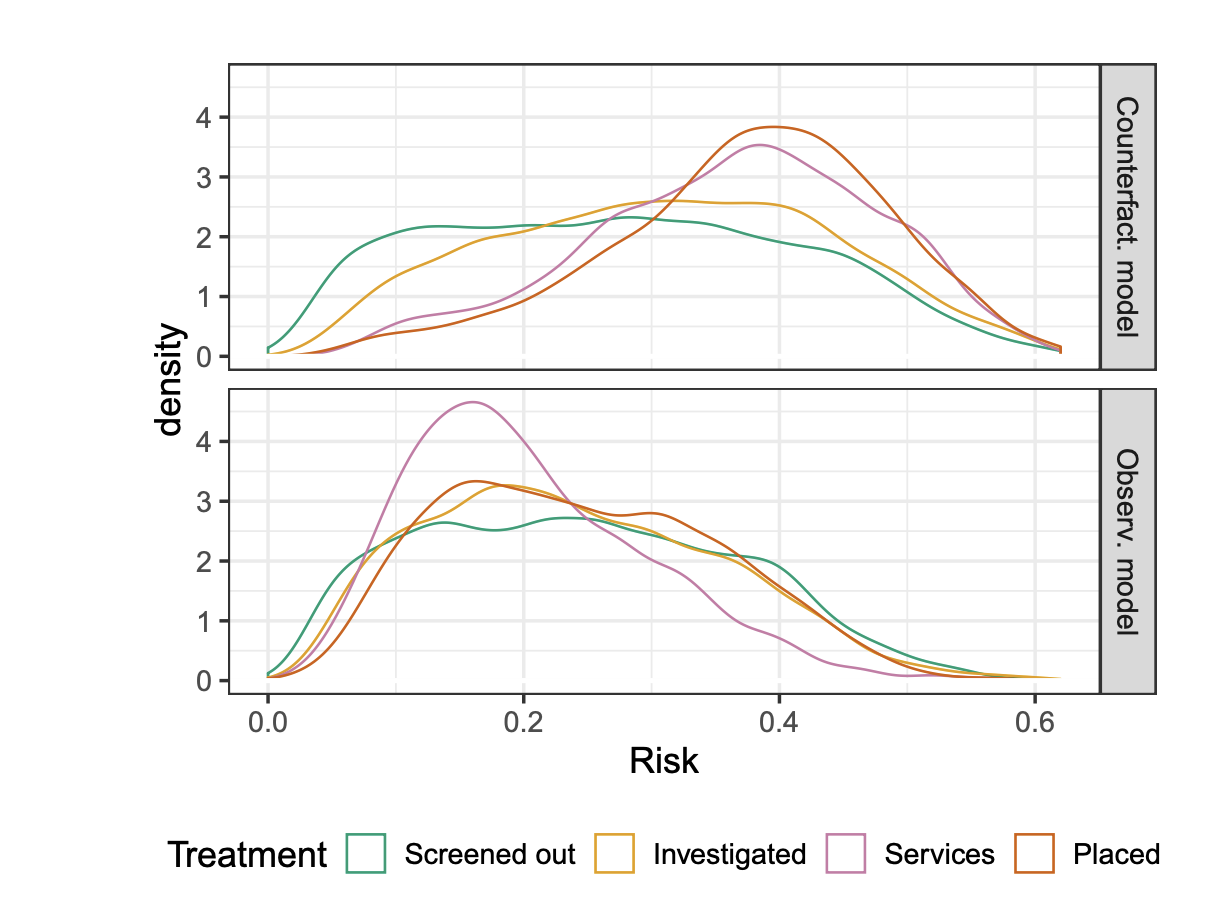 |
Abstract |
Paper |
ArXiv |
Talk
Algorithmic risk assessments are increasingly used to help humans make decisions in high-stakes settings, such as medicine, criminal justice and education. In each of these cases, the purpose of the risk assessment tool is to inform actions, such as medical treatments or release conditions, often with the aim of reducing the likelihood of an adverse event such as hospital readmission or recidivism. Problematically, most tools are trained and evaluated on historical data in which the outcomes observed depend on the historical decision-making policy. These tools thus reflect risk under the historical policy, rather than under the different decision options that the tool is intended to inform. Even when tools are constructed to predict risk under a specific decision, they are often improperly evaluated as predictors of the target outcome. Focusing on the evaluation task, in this paper we define counterfactual analogues of common predictive performance and algorithmic fairness metrics that we argue are better suited for the decision-making context. We introduce a new method for estimating the proposed metrics using doubly robust estimation. We provide theoretical results that show that only under strong conditions can fairness according to the standard metric and the counterfactual metric simultaneously hold. Consequently, fairness-promoting methods that target parity in a standard fairness metric may --- and as we show empirically, do --- induce greater imbalance in the counterfactual analogue. We provide empirical comparisons on both synthetic data and a real world child welfare dataset to demonstrate how the proposed method improves upon standard practice. |
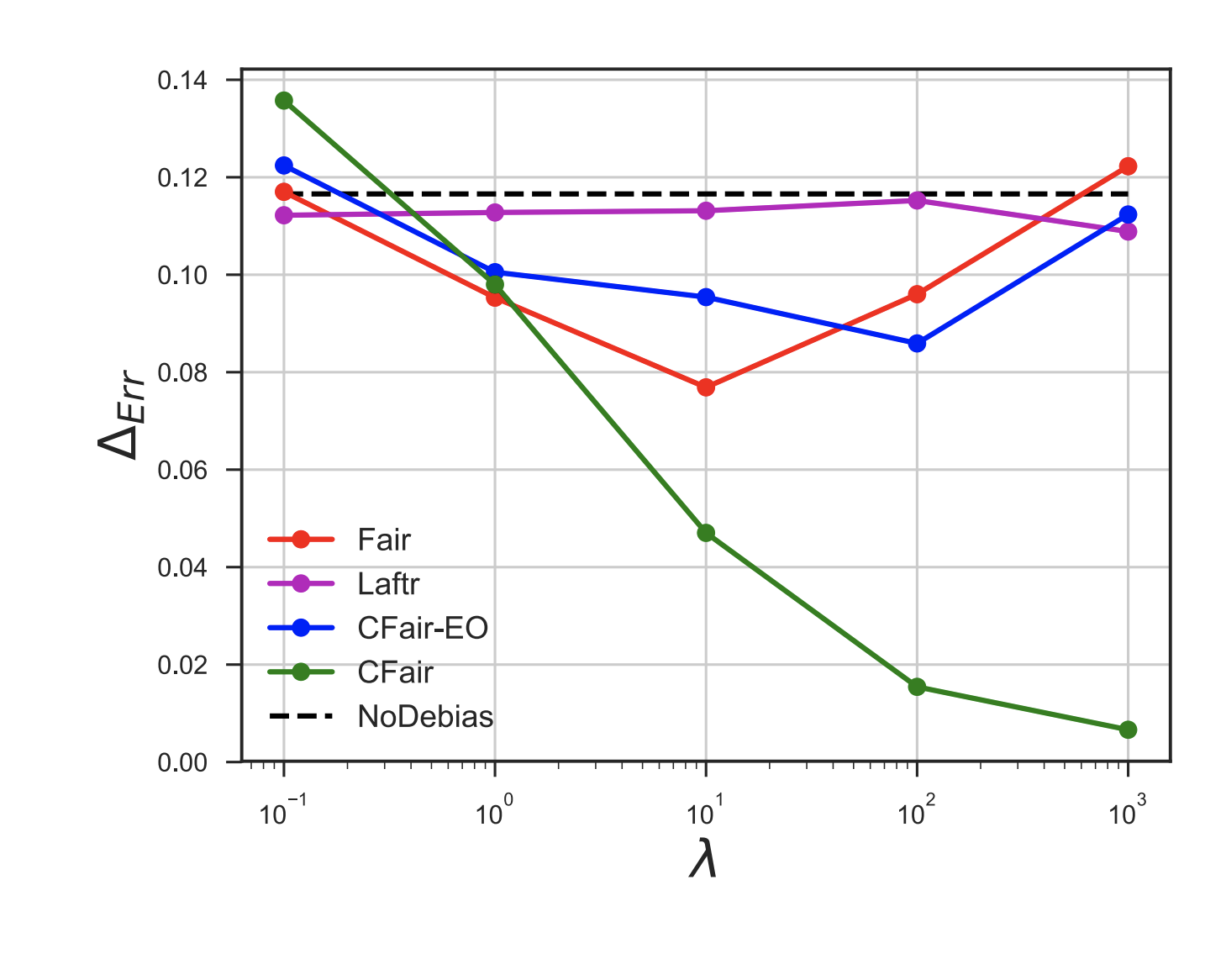 |
(ICLR), 2020
Abstract |
Paper |
ArXiv |
Talk
We propose a novel algorithm for learning fair representations that can simultaneously mitigate two notions of disparity among different demographic subgroups in the classification setting. Two key components underpinning the design of our algorithm are balanced error rate and conditional alignment of representations. We show how these two components contribute to ensuring accuracy parity and equalized false-positive and false-negative rates across groups without impacting demographic parity. Furthermore, we also demonstrate both in theory and on two real-world experiments that the proposed algorithm leads to a better utility-fairness trade-off on balanced datasets compared with existing algorithms on learning fair representations for classification. |
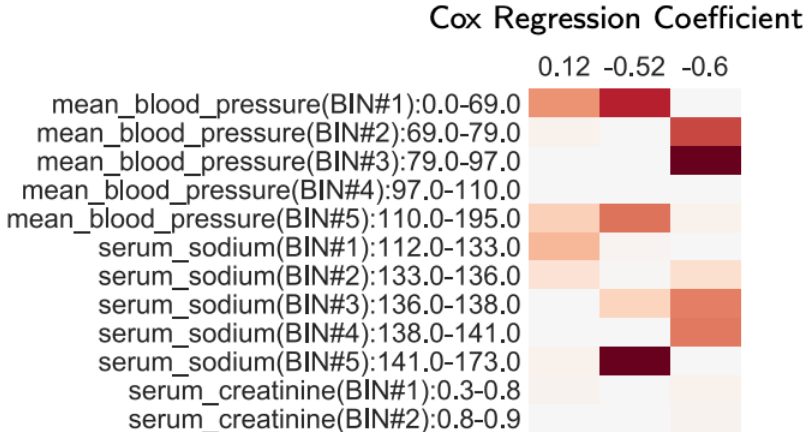 |
International Conference on Artificial Intelligence in Medicine, 2020
Abstract |
Paper |
ArXiv
In time-to-event prediction problems, a standard approach to estimating an interpretable model is to use Cox proportional hazards, where features are selected based on lasso regularization or stepwise regression. However, these Cox-based models do not learn how different features relate. As an alternative, we present an interpretable neural network approach to jointly learn a survival model to predict time-to-event outcomes while simultaneously learning how features relate in terms of a topic model. In particular, we model each subject as a distribution over "topics", which are learned from clinical features as to help predict a time-to-event outcome. From a technical standpoint, we extend existing neural topic modeling approaches to also minimize a survival analysis loss function. We study the effectiveness of this approach on seven healthcare datasets on predicting time until death as well as hospital ICU length of stay, where we find that neural survival-supervised topic models achieves competitive accuracy with existing approaches while yielding interpretable clinical "topics" that explain feature relationships. |
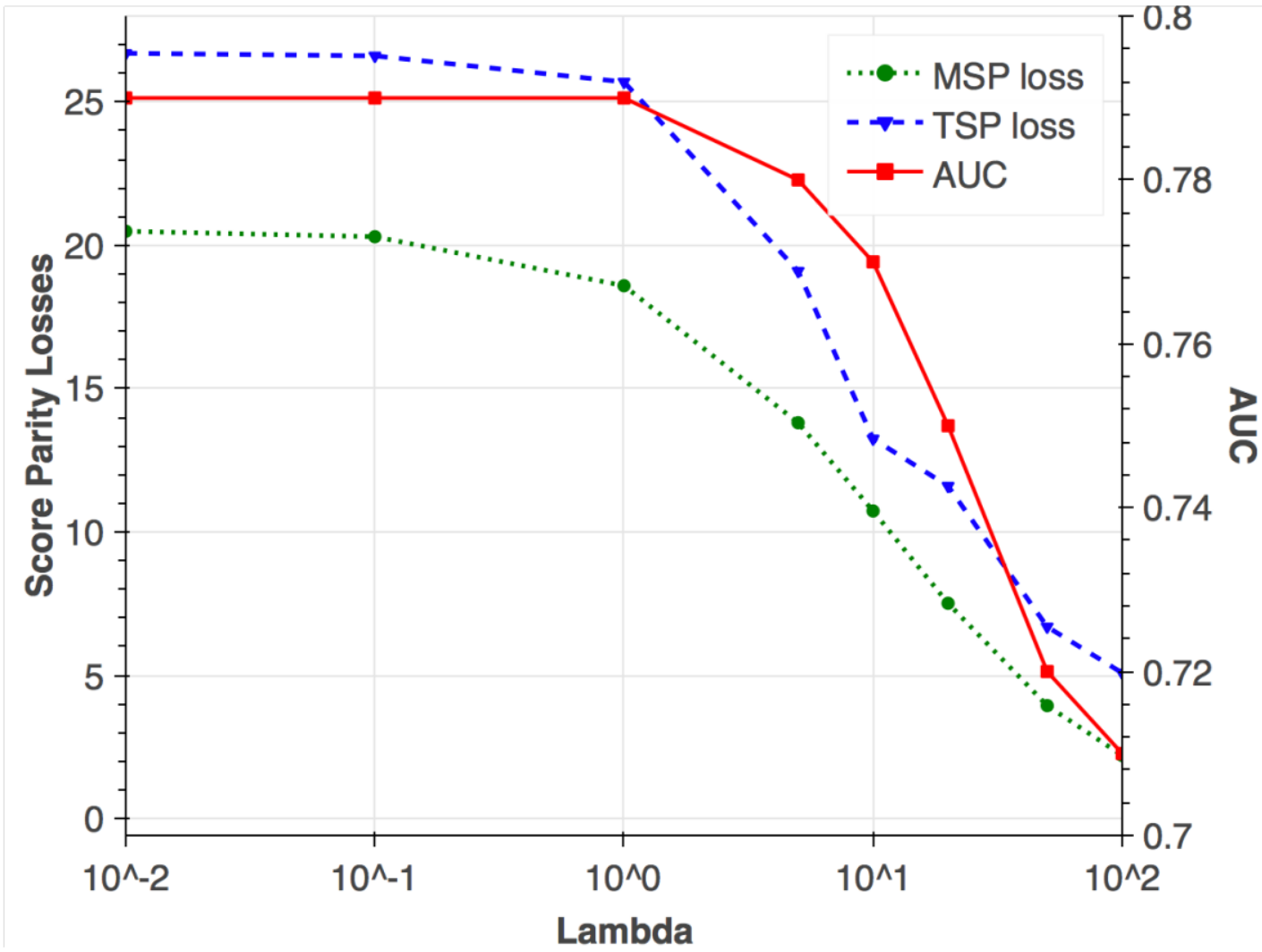 |
Abstract |
Paper
Risk assessment is a growing use for machine learning models. When used in high-stakes applications, especially ones regulated by anti-discrimination laws or governed by societal norms for fairness, it is important to ensure that learned models do not propagate and scale any biases that may exist in training data. In this paper, we add on an additional challenge beyond fairness: unsupervised domain adaptation to covariate shift between a source and target distribution. Motivated by the real-world problem of risk assessment in new markets for health insurance in the United States and mobile money-based loans in East Africa, we provide a precise formulation of the machine learning with covariate shift and score parity problem. Our formulation focuses on situations in which protected attributes are not available in either the source or target domain. We propose two new weighting methods: prevalence-constrained covariate shift (PCCS) which does not require protected attributes in the target domain and target-fair covariate shift (TFCS) which does not require protected attributes in the source domain. We empirically demonstrate their efficacy in two applications. |
| Amanda particularly enjoys teaching and mentorship opportunties. She is the instructor for Causal Inference (STAT 156/256) at UC Berkeley. She served as a teaching assistant for Matt Gormley and Tom Mitchell's Introduction to Machine Learning in 2021. She served as a project lead of the AI4ALL summer program at CMU, where she introduced high school students to algorithmic fairness in the criminal justice system using the COMPAS dataset (see Github project). As an undergraduate, she was a teaching assistant for Brian Kernighan's Computers in our World course at Princeton. |
| Referee | Nature Human Behaviour. |
| Referee | Harvard Data Science Review. |
| Referee | JASA. |
| Referee | Transactions on Machine Learning Research. |
| Referee | Journal of Royal Statistical Society Series B. |
| Referee | Data Mining and Knowledge Discovery. |
| Steering Committee | ML4D workshop 2022, 2021, 2020, 2019. |
| Reviewer | ICML 2022, 2021, 2020, 2024. |
| Reviewer | ICLR 2023, 2022. |
| Ethical reviewer | NeurIPS 2022, 2021. |
| Reviewer | NeurIPS 2022, 2021, 2020. |
| Reviewer | NeurIPS Datasets and Benchmarks 2022, 2021. |
| Program Committee | EAAMO 2022. |
| Program Committee | FAccT 2022, 2021, 2020. |
| Area Chair | ICLR Workshop on Responsible AI 2021. |
| Program Commitee | AIES 2020. |
| Program Committee | AAAI Emerging Track on AI for Social Impact 2020. |
| Program Committee | IJCAI Workshop on AI for Social Good 2019. |
| Co-organizer | Fairness, Ethics, Accountability, and Transparency (FEAT) reading group at CMU 2019-2020. |
| Co-organizer | ML4D workshop at NeurIPS 2018 and NeurIPS 2019. ML4D showcases ML research by and for the developing world. |
| Amanda graduated from Princeton University in 2013 with a degree in computer science and a certificate in the Princeton School of Public Policy and International Affairs. For her undergraduate thesis, she analyzed how machine learning techniques can improve the diagnosis of pediatric tuberculosis in collaboration with Jocelyn Tang ('14) and under the guidance of Robert Schapire. In 2019 she earned her Master of Science in Machine Learning from CMU. |
|
Evans Hall |
Template modified from here |
